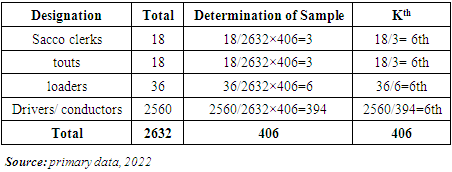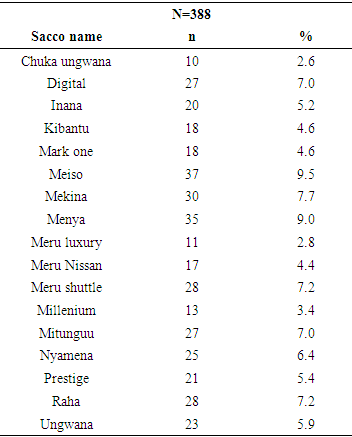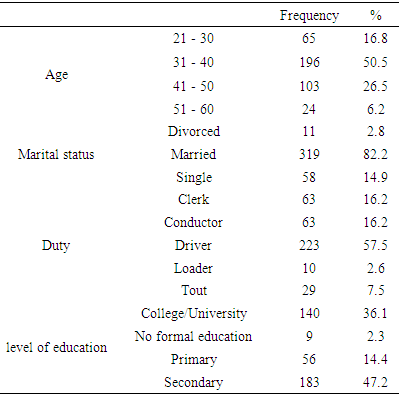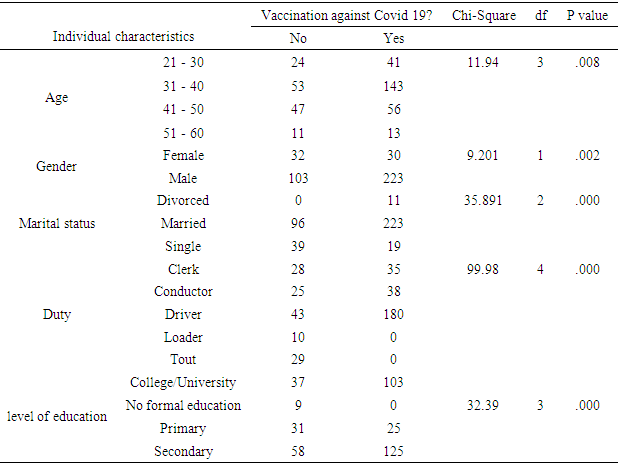-
Paper Information
- Paper Submission
-
Journal Information
- About This Journal
- Editorial Board
- Current Issue
- Archive
- Author Guidelines
- Contact Us
Public Health Research
p-ISSN: 2167-7263 e-ISSN: 2167-7247
2022; 12(3): 78-82
doi:10.5923/j.phr.20221203.03
Received: Aug. 19, 2022; Accepted: Sep. 5, 2022; Published: Sep. 15, 2022

Individual Factors Associated with Uptake of Covid Vaccine Among Matatu Crew in Meru Matatu Stage, Meru County, Kenya
Muthee Justin Thuranira, Kawila Caroline, Kimemia Fredrick
Kenya Methodist University, Kenya
Correspondence to: Muthee Justin Thuranira, Kenya Methodist University, Kenya.
| Email: |  |
Copyright © 2022 The Author(s). Published by Scientific & Academic Publishing.
This work is licensed under the Creative Commons Attribution International License (CC BY).
http://creativecommons.org/licenses/by/4.0/

The uptake of COVID-19 vaccines is an essential aspect towards enabling effective control on the spread of the virus. It is important that matatu crew, together with the vulnerable groups should receive vaccination to lower the incidence and disease transmission rate. In the Covid 19 vaccination campaign this group has been greatly sidelined. The study is aimed at determining individual factors that predict uptake of the Corona Virus 19 vaccine amongst the Matatu crew in Meru matatu stage. The study population was Matatu crew in Meru matatu stage. Sampling size determination was done using the Fischer’s formula. The sampling technique was systematic among the drivers, touts and conductors in Meru Matatu stage, while purposive selection was done among the key informants. The study used of questionnaire for quantitative and for qualitative data collection an interview guide was used. Data analysis from the self-administered questionnaire was analyzed quantitatively using descriptive statistics like frequencies and proportions. Chi-square analysis was used to capture associations amongst the categorical variables. Further, statistical significance was placed at p<0.05. Qualitative data was analyzed through the use of thematic analysis. Results were presented in tables, pie charts and bar graphs for ease of understanding. The study found a low uptake of Covid 19 vaccine among the Matatu operators. Individual characteristics such age (χ2=11.94, α=0.008), duty (χ2=99.98, α=0.00) marital status (χ2=35.891, α=0.00), education level (χ2=32.39, α=0.00), gender (χ2=9.021, α=0.002) were significantly associated with low COVID 19 uptake among the Matatu Crew operators. The study concluded that there was low uptake of Covid -19 vaccine among the Matatu crew in Meru and this was affected mostly by the individual characters of the crew. From the findings, the study recommended that the county health team should involve and train the Sacco official to deliver the Covid 19 vaccine. Further research should be done to determine other social mechanisms of improving Vaccine uptake and reducing misinformation towards emergency vaccines.
Keywords: Matatu crew, Predictors, Vaccination, Vaccineuptake
Cite this paper: Muthee Justin Thuranira, Kawila Caroline, Kimemia Fredrick, Individual Factors Associated with Uptake of Covid Vaccine Among Matatu Crew in Meru Matatu Stage, Meru County, Kenya, Public Health Research, Vol. 12 No. 3, 2022, pp. 78-82. doi: 10.5923/j.phr.20221203.03.
Article Outline
1. Introduction
- The recently experienced global pandemic caused by Coronavirus disease 2019 (COVID-19) which is largely spread via respiratory droplets has resulted in a sudden substantial rise in hospitalizations for pneumonia related symptoms and/with multiple organ failure (Pan et al., 2020). Of great concern is the fact that the disease can be transmitted by both asymptomatic and symptomatic carriers. It takes approximately one week for symptoms to show, within which the asymptomatic person will still be infectious. Commonly, the symptoms are mimic common cold and flu, with most patients presenting with shortness of breath, dry cough and fever (Cheng et al., 2021).COVID-19 was first reported in Wuhan, China from a group of patients presenting with pneumonia of unknown etiology at the close of 2019 (Pan et al., 2020). It then spread all over the world within a short time. In as much as some of the people who contract the COVID-19 disease only experience mild or moderate symptoms and thereafter recover with ordinary common cold treatment, some become seriously ill and require specialized medical attention with critical hospitalization (Cheng et al., 2021).Natural immunity can be acquired from getting the virus that causes COVID-19 and this may give some protection. However, the risk that comes with severe illness, strain on the healthcare system and deaths associated with COVID-19 dwarf benefits of natural immunity (WHO, 2021). COVID-19 vaccination is therefore necessary to help in creating an antibody response without this risk of severe disease. Currently, more than one hundred vaccines are being investigated and several of them are already authorized by medical agencies. The infection rates of COVID-19 cases highlights the need to ensure increased levels of vaccination to limit the spread of the disease (Mant et al., 2021). Despite multiple vaccines that have been introduced to help halt the occurrence of these conditions there is still a high extent of Corona Virus vaccine hesitancy from the public (Tavolacci et al., 2021). This is highly likely to impair all the efforts directed towards limiting this trend (Tavolacci et al., 2021). According to WHO (2019) vaccine hesitancy ranks in the top ten threats in the world as irrespective of the availability of vaccines, such trends limit the capability of dealing with vaccine-preventable illnesses.
2. Research Objective
- The study sought to determine the individual factors associated with the uptake of COVID vaccine among Matatu crew in Meru Matatu stage.
3. Methodology
- The approach that was used in this study is a cross sectional descriptive research design. Additionally, a mixed research design was used to allow collection, analyzing and integration of qualitative as well as quantitative research (Ngechu, 2004). The study was done in Meru town which is in the eastern side of Kenya. The study population of this study were the Matatu crew in Meru Matatu stage. All Saccos (18) within the Meru stage were sampled. At any given time, the Meru stage can accommodate 400 Matatus with matatus taking an average 30 minutes to load/ofload. On average the stage is usually at 80% capacity according to the head stage manager. The population of this study were 18 Sacco office clerks (1 per sacco), 18 touts (1 per sacco), 36 loaders and 2560 drivers or conductors(1 respondent from each Matatu) for the duration of data collection (4hours*2*320). The inclusion criteria for drivers and conductors who were at the Meru Matatu stage on the day of data collection, and bearing Sacco identification badges. This is shown in the table below.
|

 Where:n = sample size desiredZ = the Standard normal deviation (1.96, or a confidence interval of 95% p = the estimated proportion with the characteristic of interest (placed at 40% for this study)q = 1-pandd = is the desired degree of accuracy. This is set at 0.05.
Where:n = sample size desiredZ = the Standard normal deviation (1.96, or a confidence interval of 95% p = the estimated proportion with the characteristic of interest (placed at 40% for this study)q = 1-pandd = is the desired degree of accuracy. This is set at 0.05. = 368.6
= 368.6  369A 10% Sample size adjustment was applied to take care of non-response and incomplete questionnaires110% (369) = 406In order to accord every eligible respondent equal probability of selection, Simple Random Sampling technique was used. Procedure proportionate to size or stratification was also applied as shown in the table 2 below
369A 10% Sample size adjustment was applied to take care of non-response and incomplete questionnaires110% (369) = 406In order to accord every eligible respondent equal probability of selection, Simple Random Sampling technique was used. Procedure proportionate to size or stratification was also applied as shown in the table 2 below
|
4. Results
- The total number of participants distributed according to the various termini they were working from.
|
|
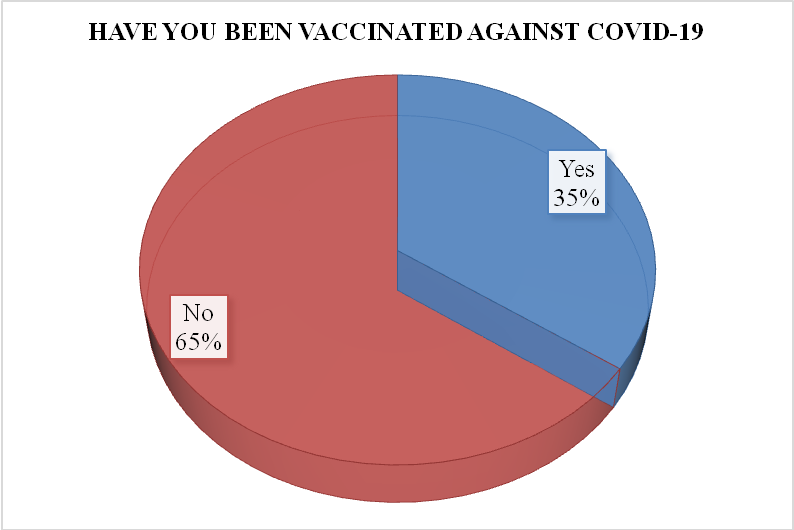 | Figure 1. Vaccination Against Covid-19 |
|
5. Conclusions and Recommendations
- According to the findings of the research, there was a poor uptake of the Covid 19 vaccination among the matatu drivers. Individual variables such as age (2 = 11.94, =0.008), duty (2 = 99.98, =0.00), married status (2 =35.891, =0.00), education level (2 =32.39, =0.00), and gender (2 =9.021, =0.002) were significantly linked with poor COVID 19 uptake among the Matatu Crew operators. The study concluded that Individual characteristics such age, duty, marital status were associated with low COVID 19 uptake among the operators and therefore recommended that further research should be done to determine other social mechanisms of improving Vaccine uptake and reducing misinformation towards emergency vaccines.
 Abstract
Abstract Reference
Reference Full-Text PDF
Full-Text PDF Full-text HTML
Full-text HTML
